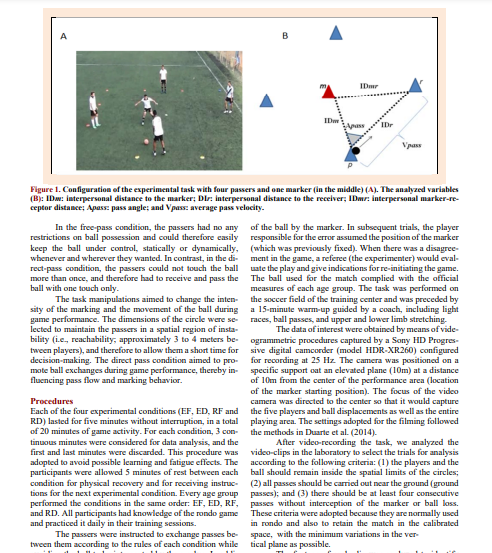The dynamics of combined passes is thought to be one of the most striking features of modern soccer (Tenga et al., 2010). Barcelona FC, for example, typically has a game style (Chassy, 2013) characterized by fast, accurate, and locally built passes capable of breaking the stability of the opposing team (Paixão et al., 2015).
This style of play was considered an evolutionary phenomenon in elite soccer (Barreira et al., 2015) and has attracted the attention of spectators, coaches, and sports scientists.
For example, Paixão et al. (2015) showed that players using this style act more grouped, particularly in the half field sector, due to the defensive strategies and balance between the teams.
This configuration caused higher density and congestion of players in the center of the field, thereby affecting the distances covered by the players, their passing style, and the overall ball speed (Kuhn, 2005).
Thus, to perform a successful pass and take advantage of the action opportunities offered by the dynamic structure of the game, a player needs to perceive the location of a teammate and then pass the ball with a specific speed and direction.
Indeed, in competitive team games, opportunities to make a pass arise and disappear according to the spatiotemporal relationships established between competing performers (Travassos et al., 2012a).
Recently, ecological dynamics has been proposed as a reliable theoretical framework to examine sport performance based on performer-environment relationships, i.e., at the ecological scale of analysis (Araújo et al., 2006).
These studies revealed that players couple their actions in space and time to information emerging from key environmental and task constraints during performance (Travassos et al., 2012c).
Thus, successfully using the opportunities for action (i.e., affordances) that emerge as individuals interact with their environment ultimately sustains adaptive performance behaviours and task achievement.
The ecological theoretical approach raises the hypothesis that experiencing unfavourable situations in the teaching-learning environment encourages players to explore the information from key environmental and task constraints and thereby create potential innovative gameplay solutions (Davids et al., 2013; Passos and Davids, 2015; Silva et al., 2016).
A few studies examined how the manipulation of specific constraints in small-sided and conditioned games (SSCG's), such as the number of players (Silva et al., 2015; Travassos et al., 2012c) and the spatial dimension of the game (Silva et al., 2014; Vilar et al., 2014), can influence interpersonal interactions.
Indeed, such manipulations affected the spatial relationship between the players because they imposed continuous and diversified co-adaptations between attackers and defenders.
For example, decreasing relative space constrains the interactions between players, as they have less time and space to act.
These spatiotemporal constraints produce new information for ball-passing opportunities, which in turn promotes certain patterns of behavior by teammates and opponents.
Previous research addressing the effects of field dimensions on tactical behavior reported different co-adaptations among players, depending on the available space between them. Silva et al (2014) observed larger trajectories of the players' movements in smaller game spaces.
In addition, Vilar et al. (2014) showed that in smaller spaces, the players reduce their ball possession time by encouraging the exchange of passes and by increasing the rhythm of the game.
These results suggest that key manipulations force players to engage in different functional-tactical behaviors, such as dribbling, passing, kicking, and marking, to create potential game-play solutions.

